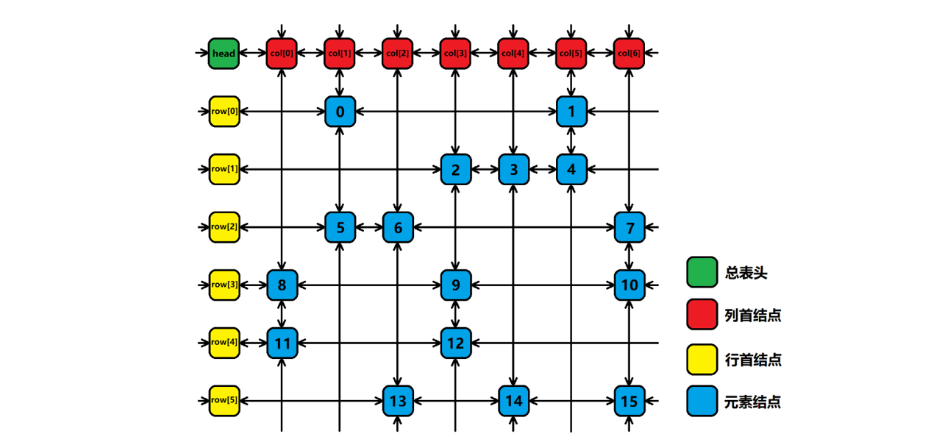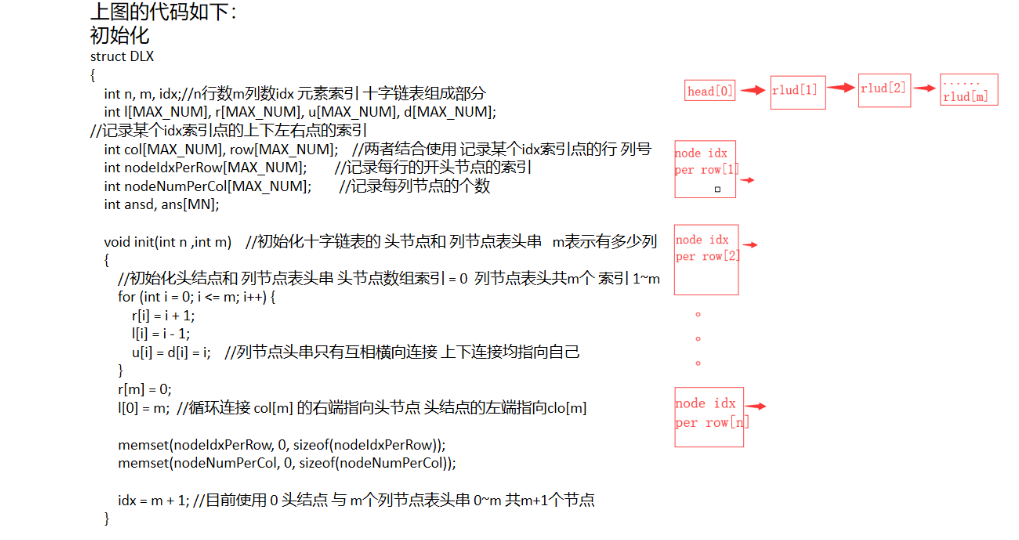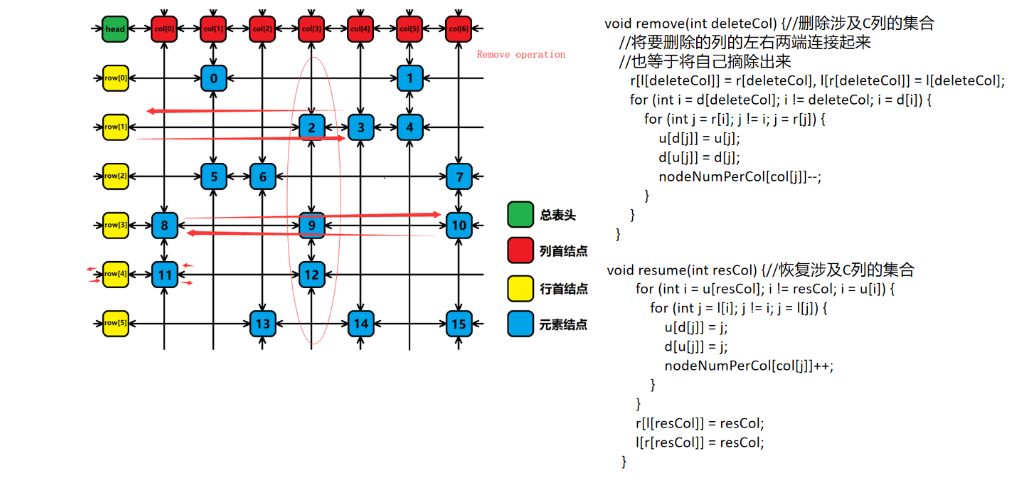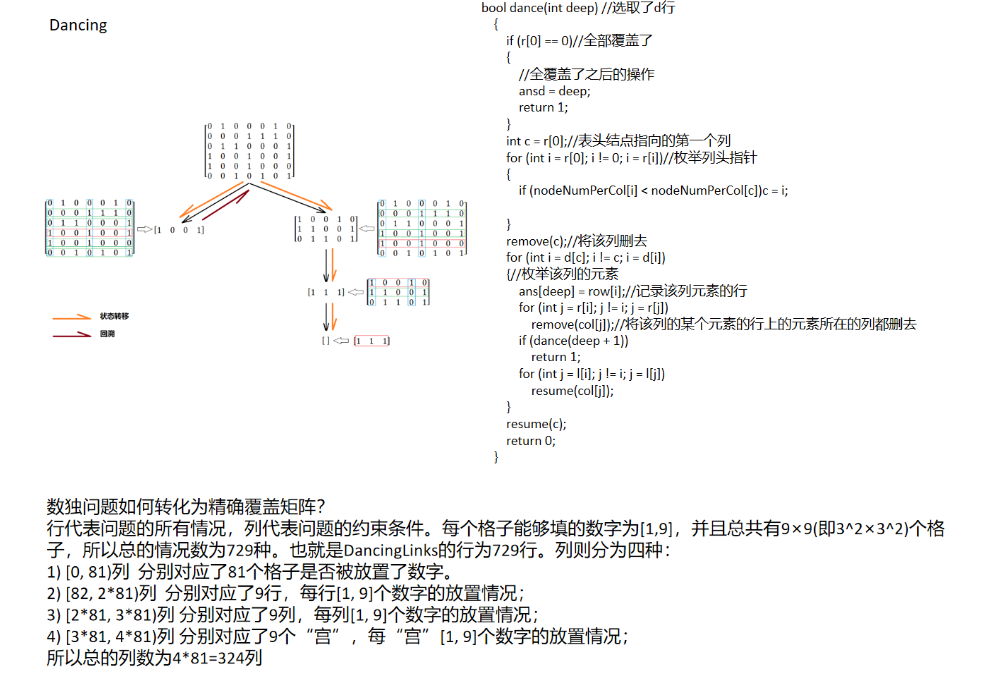166. 数独 dancing links 方法
dfs硬怼通过数独 N皇后的代码后 想学习下新的数据结构和算法来解决这类覆盖问题
习题练习
https://www.acwing.com/problem/content/168/ 数独
https://www.acwing.com/problem/content/171/ 数独2
https://www.acwing.com/problem/content/185/ 靶形数独
资料收集如下 进行学习
https://www.cnblogs.com/ivan-count/p/7355431.html
https://www.cnblogs.com/grenet/p/3145800.html
https://blog.csdn.net/whereisherofrom/article/details/79220897
习题学习
洛谷
https://www.luogu.org/problem/P4929 P4929 【模板】舞蹈链(DLX)
https://www.luogu.org/problem/P1074 P1074 靶形数独
https://www.luogu.org/problem/P1219 P1219 八皇后
题解
https://www.luogu.org/blog/ONE-PIECE/qian-tan-dlx 【模板】舞蹈链(DLX)
https://www.luogu.org/blog/ONE-PIECE/ba-xing-shuo-du-dai-ma 靶形数独
https://www.luogu.org/blog/ONE-PIECE/solution-p1219 八皇后









我的对模板注释的代码 参考的源代码地址https://www.luogu.org/blog/ONE-PIECE/qian-tan-dlx
#include <iostream>
#include <stdio.h>
#include <string.h> //精确覆盖问题的定义:给定一个由0-1组成的矩阵,是否能找到一个行的集合,使得集合中每一列都恰好包含一个1
const int MN = * * + ;//最大行数,共有9*9个格子,每个格子可以放1~9
const int MM = * + * + * + * + ;//最大列数
const int MAX_NUM = MN * MM; //最大点数 struct DLX
{
int n, m, idx;//n行数m列数idx 元素索引
//十字链表组成部分 int l[MAX_NUM], r[MAX_NUM], u[MAX_NUM], d[MAX_NUM]; //记录某个idx索引点的上下左右点的索引
int col[MAX_NUM], row[MAX_NUM]; //两者结合使用 记录某个idx索引点的行 列号 int nodeIdxPerRow[MAX_NUM]; //记录每行的开头节点的索引
int nodeNumPerCol[MAX_NUM]; //记录每列节点的个数 int ansd, ans[MN]; void init(int n ,int m) //初始化十字链表的 头节点和 列节点表头串 m表示有多少列
{
//初始化头结点和 列节点表头串 头节点数组索引 = 0 列节点表头共m个 索引 1~m
for (int i = ; i <= m; i++) {
r[i] = i + ;
l[i] = i - ;
u[i] = d[i] = i; //列节点头串只有互相横向连接 上下连接均指向自己
}
r[m] = ;
l[] = m; //循环连接 col[m] 的右端指向头节点 头结点的左端指向clo[m] memset(nodeIdxPerRow, , sizeof(nodeIdxPerRow));
memset(nodeNumPerCol, , sizeof(nodeNumPerCol)); idx = m + ; //目前使用 0 头结点 与 m个列节点表头串 0~m 共m+1个节点
} //插入节点 进行的一些数据记录
void link(int insertRow, int insertCol)
{
nodeNumPerCol[insertCol]++; //插入一个节点 那么该列的节点个数+1
row[idx] = insertRow;
col[idx] = insertCol; //记录第idx个节点所在的行与列 u[idx] = insertCol; //当前插入的节点索引记录 向上指向列节点头串中的insertCol
d[idx] = d[insertCol]; //当前插入节点索引记录 向下指向原来列节点头串的向下指向点
u[d[insertCol]] = idx; //原来列节点头串指向的节点 向上由指向列节点头串指向插入的节点(使用索引)
d[insertCol] = idx; //列节点头串则向下指向新插入的节点(使用索引) //更新每行的节点记录 nodeIdxPerRow
if (nodeIdxPerRow[insertRow] == ) {
//如果该节点是第一个插入的节点
nodeIdxPerRow[insertRow] = r[idx] = l[idx] = idx;//该行没有点,直接加入
}
else {
//如果不是第一个插入的节点 同上面处理列次序一样 在记录和第一个节点间 插入本函数插入的节点
r[idx] = nodeIdxPerRow[insertRow]; //新节点的右端指向原来行记录中的第一个节点
l[idx] = l[nodeIdxPerRow[insertRow]]; //新节点的左端指向原来行记录第一个节点的左端 也就是行记录nodeIdxPerRow
r[l[nodeIdxPerRow[insertRow]]] = idx; //原来行记录第一个节点的左端(也就是行记录nodeIdxPerRow)的右端 指向新插入的点(使用索引)
l[nodeIdxPerRow[insertRow]] = idx; //原来行记录第一个节点的左端指向新插入的节点(使用索引) }
idx++;
return;
} void remove(int deleteCol) {//删除涉及C列的集合
//将要删除的列的左右两端连接起来 也等于将自己摘除出来
r[l[deleteCol]] = r[deleteCol], l[r[deleteCol]] = l[deleteCol];
for (int i = d[deleteCol]; i != deleteCol; i = d[i]) {
for (int j = r[i]; j != i; j = r[j]) {
u[d[j]] = u[j];
d[u[j]] = d[j];
nodeNumPerCol[col[j]]--;
}
}
}
void resume(int resCol) {//恢复涉及C列的集合
for (int i = u[resCol]; i != resCol; i = u[i]) {
for (int j = l[i]; j != i; j = l[j]) {
u[d[j]] = j;
d[u[j]] = j;
nodeNumPerCol[col[j]]++;
}
}
r[l[resCol]] = resCol;
l[r[resCol]] = resCol;
} bool dance(int deep) //选取了d行
{
if (r[] == )//全部覆盖了
{
//全覆盖了之后的操作
ansd = deep;
return ;
} int c = r[];//表头结点指向的第一个列
for (int i = r[]; i != ; i = r[i])//枚举列头指针
{
if (nodeNumPerCol[i] < nodeNumPerCol[c])c = i; } remove(c);//将该列删去
for (int i = d[c]; i != c; i = d[i])
{//枚举该列的元素
ans[deep] = row[i];//记录该列元素的行
for (int j = r[i]; j != i; j = r[j])
remove(col[j]);//将该列的某个元素的行上的元素所在的列都删去
if (dance(deep + ))
return ;
for (int j = l[i]; j != i; j = l[j])
resume(col[j]);
}
resume(c);
return ;
}
}dlx;
//========================================================== char s[], path[];
struct node
{
int r, c, v;
}nds[MN];
int main()
{
while (~scanf("%s", s))
{
if (s[] == 'e')break;
dlx.init( * * , * * );
int r = ;
for (int i = ; i <= ; i++)
{
for (int j = ; j <= ; j++)
{
if (s[(i - ) * + j - ] == '.')
{
for (int z = ; z <= ; z++)
{
dlx.link(r, (i - ) * + j);
dlx.link(r, + (i - ) * + z);
dlx.link(r, + (j - ) * + z);
dlx.link(r, + (((i - ) / ) * + (j + ) / - ) * + z);
nds[r].r = i, nds[r].c = j, nds[r].v = z;
r++;
}
}
else
{
int z = s[(i - ) * + j - ] - '';
dlx.link(r, (i - ) * + j);
dlx.link(r, + (i - ) * + z);
dlx.link(r, + (j - ) * + z);
dlx.link(r, + (((i - ) / ) * + (j + ) / - ) * + z);
nds[r].r = i, nds[r].c = j, nds[r].v = z;
r++;
}
}
}
dlx.ansd = -;
dlx.dance();
int deep = dlx.ansd;
for (int i = ; i < deep; i++)
{
int posr = dlx.ans[i];
path[(nds[posr].r - ) * + nds[posr].c - ] = '' + nds[posr].v;
}
path[deep] = '\0';
printf("%s\n", path);
}
return ;
}
最新文章
- POJ 3522 Slim Span 最小生成树,暴力 难度:0
- Leetcode#126 Word Ladder II
- android 根据SD卡中图片路径读取并显示SD中的图片——源代码
- C Primer Plus之C预处理器和C库
- 函数ut_2_log
- Perl多进程
- 关于grub的那些事(一)
- unittest模块的常用方法:
- SpringBoot基础系列-SpringCache使用
- Kubernetes实战:目录
- Java核心技术及面试指南 异常部分的面试题归纳以及答案
- LOJ #2142. 「SHOI2017」相逢是问候(欧拉函数 + 线段树)
- java程序运存扩容
- 深入浅出JavaScript(一)
- pd.concat()命令
- Azure Paas SQL 修改用户名密码的相关问题
- C++与Java混合编程
- [Selenium] 在Grid模式下打印出当前Case是在哪台Node上运行
- Spring-解决请求中文乱码问题
- rust by example 2